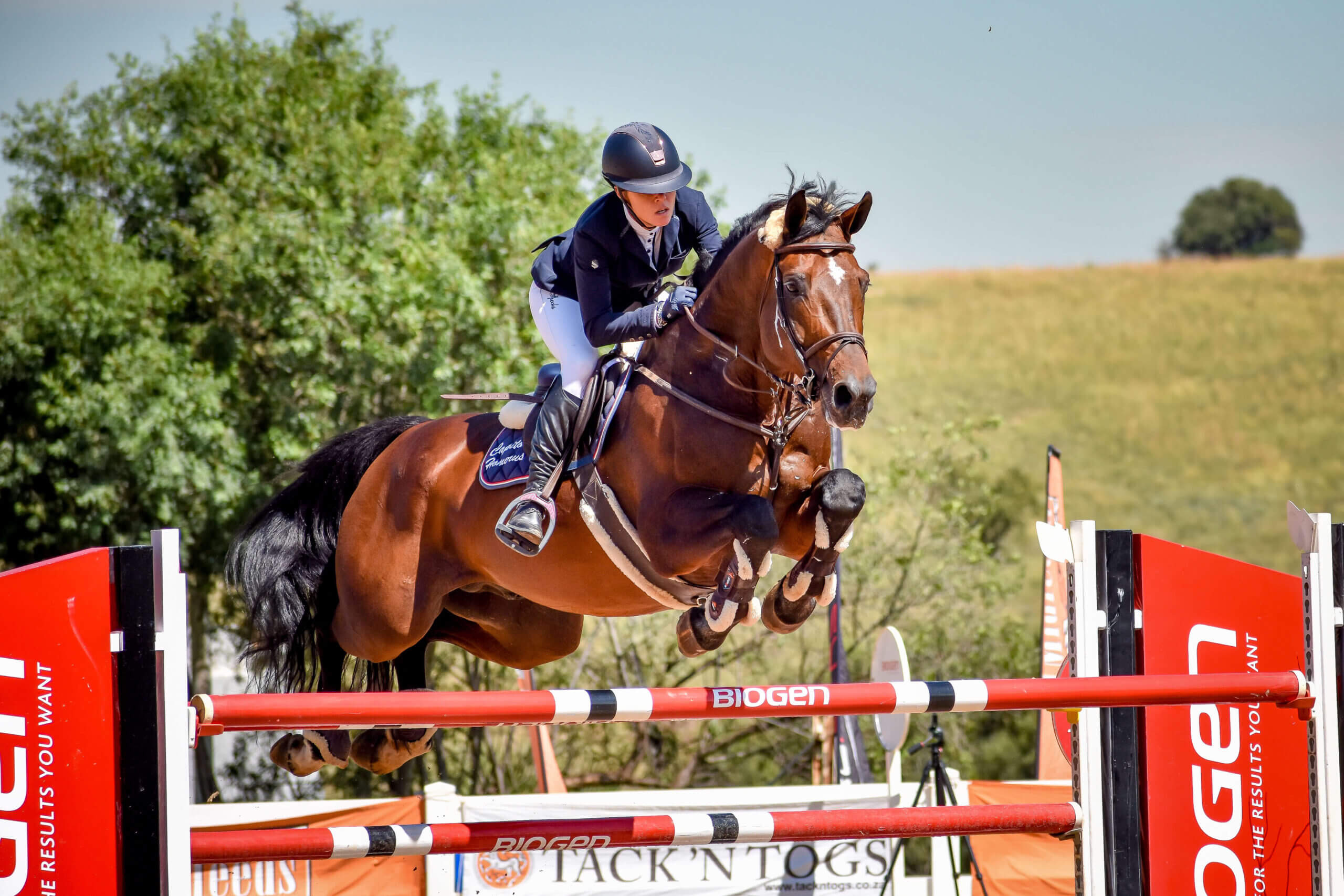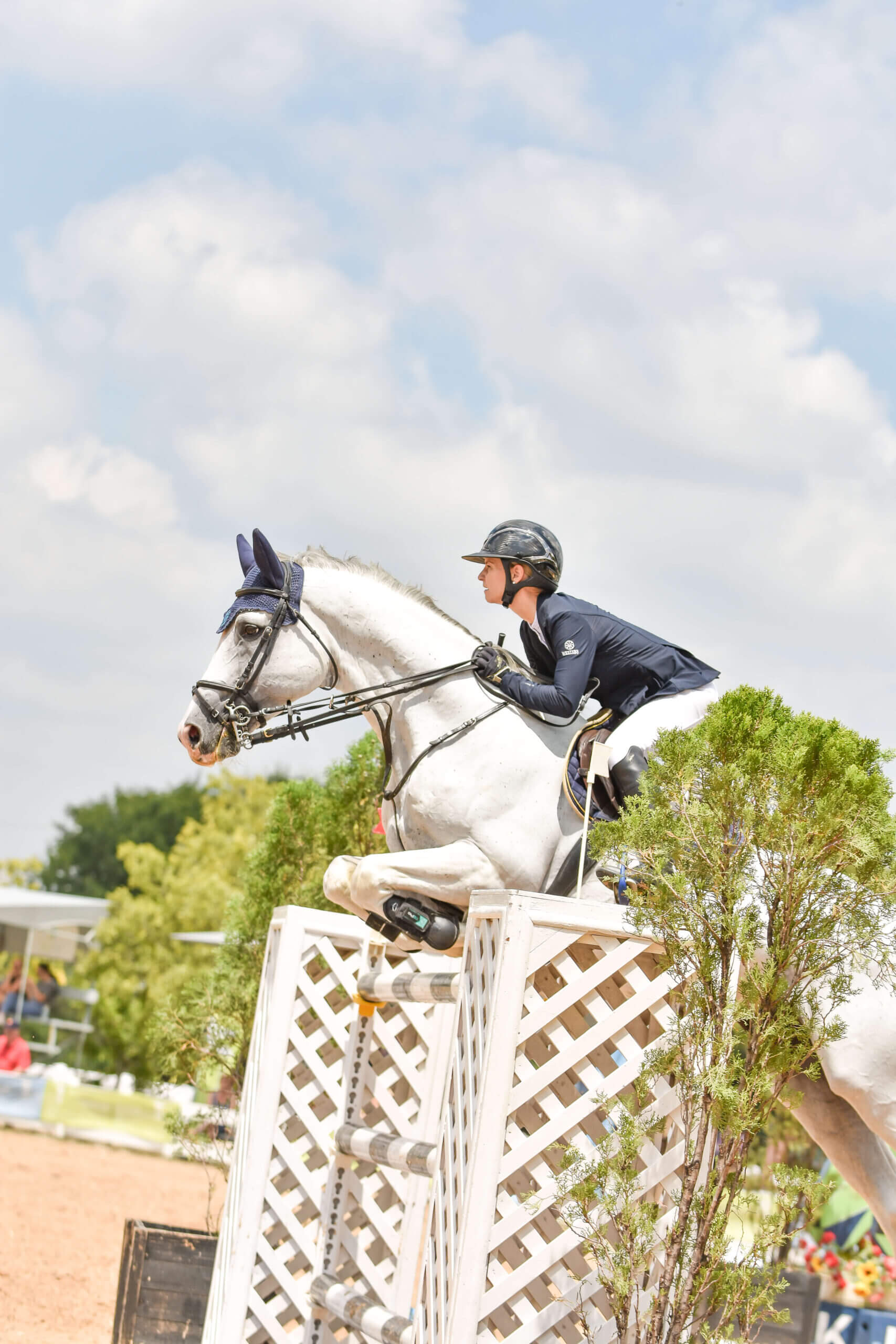The who, what, how and why…
Text: Amelia Campbell-Horne
Free jumping and loose movement have long been considered excellent ways for breeders to showcase their progeny and for buyers to see the potential of what is being produced here in South Africa. One such event held annually is the South Africa Warmblood Horses Society show that took place on the 4th of November, 2023 at Summit Ridge Equestrian Centre.
NOTE
However, research shows that there is no guarantee that your horse will perform the same in free jumping or loose movement as when he has a rider on his back.
Across Europe and America, free jumping is considered a means of assessing a horse’s jumping potential and evaluating their attitude and ability over a fence. Studies have also suggested that it may help develop a horse’s confidence, balance, and rhythm while teaching a horse to ‘see his own stride’ as he learns to adjust his stride without rider interference. In Warmblood breeding countries, free jumping and loose movement are often used for studbook selection and grading of young horses, as well as in the sale of young stock.
Free jumping
Free jumping at a young age can give you an idea of your horse’s:
- Scope
- Bravery/boldness
- Adaptability
- Potential
Free jumping for older horses can also help you discover your horse’s natural jumping style and ability, and in turn, it may help you to ride them better. For example, some horses may lower their head on take-off or landing, which riders might interpret as the horse trying to pull on the reins. If, however, you see the horse do the same thing while free jumping, you may realise this is just their style and adapt your riding accordingly. Conversely, under saddle, if you feel like your horse carries his head high in front of the jump, it may be helpful to observe how they carry themselves free jumping; perhaps your horse has a naturally higher head carriage, which helps them maintain their balance.
Fast fact
Allowing a young horse to jump improves his technique and handiness and allows the horse to gain experience. This is advantageous, but according to a study at the University of Utrecht, there is no guarantee that it will make your horse a better jumper in the future.
Loose movement
In the loose movement, judges are looking for three good paces as well as balance and self-carriage. With the walk and canter being more challenging for a rider to modify, it is particularly important to pay attention to these gaits. Another element to seek in dressage prospects is the ability to stop and turn using the hind legs rather than pulling from the shoulders.
Pro tips for free-jumping and loose-movement
- Make sure your horse is warmed up or lunged before you start jumping. Jumping a horse with cold muscles increases the risk of injury. Don’t forget to cool them off, too!
- Let the horse jump on both reins (not always possible in a competition, but beneficial in practice).
- Be sure to give the horse breaks between jumping; for young horses, the activity can be exerting and also get boring quickly.
- Always stay calm! Horses should jump willingly, not from a place of fear. A horse that is calm will approach the jumps with more focus and confidence and will be better able to learn from their mistakes.
- If it is a training session, decide beforehand what the session’s goal is and stop when you have reached it – even if it only took three jumps to get there. This will ensure your horse has a good experience and foundation for the next session!
- Make sure the arena is appropriately sized, enclosed and safe. If you are setting up a jump chute, choose a location with the entrance/exit gate in mind; e.g. jumping towards an ‘exit’ may cause the horse to rush down the line.
Past winners of the SAWHS Free Jumping and where they are now
The SAWHS Free Jumping and Loose Movement show has been held annually since 2009, so we have the opportunity to look back at past winners and assess their achievements. One of the earliest winners of the Grand Champion Showjumper for two consecutive years was Capital Homerus, who won as a three-year-old at President’s Cup in 2010 and again as a four-year-old in 2011.
Capital Homerus (Darco x Cash x Lord) went on to compete successfully in the 1.50m classes with Leona Van Der Merwe for several years. He is also the full brother to Capital Kronos, who has had a successful year jumping in the World Cup Qualifier series with Nicole Horwood.

In both years that Homerus won the Free-Jumping, Capital Hitoshi, who was a year younger, won his age category. Hitoshi (Winningmood/Sioux de Baugy) became a household favourite, winning several 1.50m Grand Prix and two World Cup Qualifiers with Nicole Horwood.

S’fikile KP Confession (Crusador x Clarinius), who recently jumped his first 1.40m class with Catherine Mcfarlane, was the Reserve Champion Jumper in 2015.
Another KP-bred horse – the eight-year-old KP Quarter-Lemon (Quality Time x Crusader) – who jumped her first 1.35m class earlier this year with Ryan Andrews, was also Reserve Champion Jumper in 2017, at just two years of age!
More recently, Neriske Prinsloo Hill’s Stallion Origan van den Bisschop (Hunters Scendro x Nabab de Reve) came second in the 2018 four-year-old jumper category. This impressive horse recently moved up to the 1.50m classes.

Many of the more recent winners are progressing smoothly up the grades, including the 2021 Champion Free-Jumper Martini Cortina and Reserve Champion Los Pepe.
Past winners of the SAWHS Loose Movement and where they are now
In 2013, Berghof Eragon (Edward x Metternnich) was second in the one-year-old Loose Movement class. As a three-year-old, he was a licensed SAW and Hanoverian stallion – the first ever African-bred horse to be licensed by the German Hanoverian Verband. He has been very successful in the dressage ring with consistent 70% plus marks.
In 2022, his daughter Glenwood Escada (Berghof Eragon X Dageraad Dirkje) won the title of Reserve Loose Movement Champion.
Past winners and their cross-over achievements
In the first year of the competition, 2009, Callaho Socrates (Stakkato x Contender) won the three-year-old Free Jumper class. Amazingly, Socrates went on to become one of the most well-known and celebrated dressage horses in South Africa. He was ridden up to Small Tour by Andrea Harrison and his owner, Christine Richardson, with frequent scores in excess of 70%. Before his untimely passing in 2022, he was ridden in front of many international judges at a few CDIs, World Dressage Challenges and SA Champs competitions and was almost always in the top three. As a final fact, Socrates was a half-brother to Callaho Lord Cris, who recently won the WCQ with George Coutlis. They both have the same dam – Crissie.
Another interesting cross-over is Swazi-Liskar Land of Lagos, who placed second in the three-year-old Loose Movement class in 2011 and then went on to jump in the 1.40m classes with Carolyn van Schalkwyk.
Stay tuned for an article on the SAWHS Free Jumping and Loose Movement Show
Follow our page for our upcoming article on the SAWHS Free Jumping and Loose Movement show that took place on the 4th November at Summit Ridge Equestrian to see the exceptional talent on offer from some of South Africa’s smaller studs.

